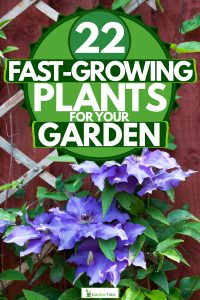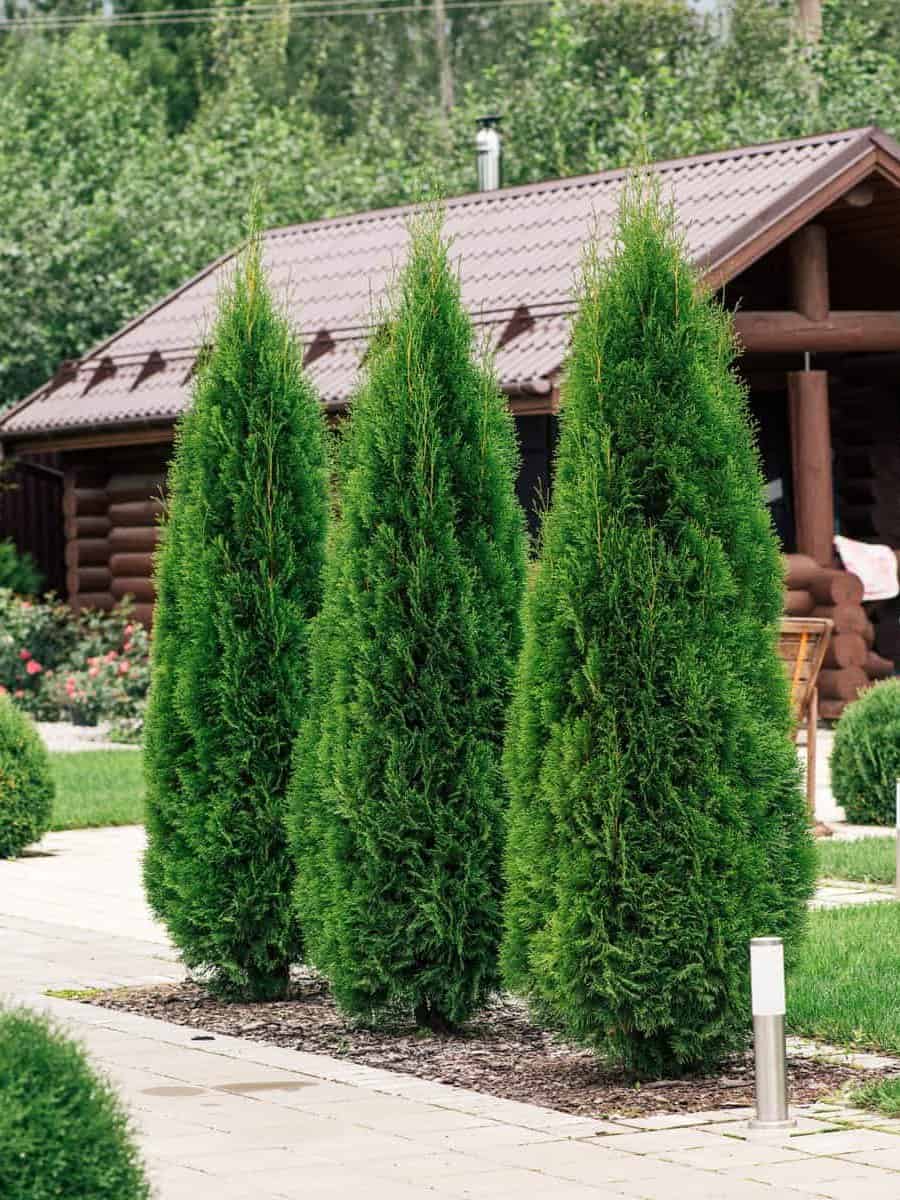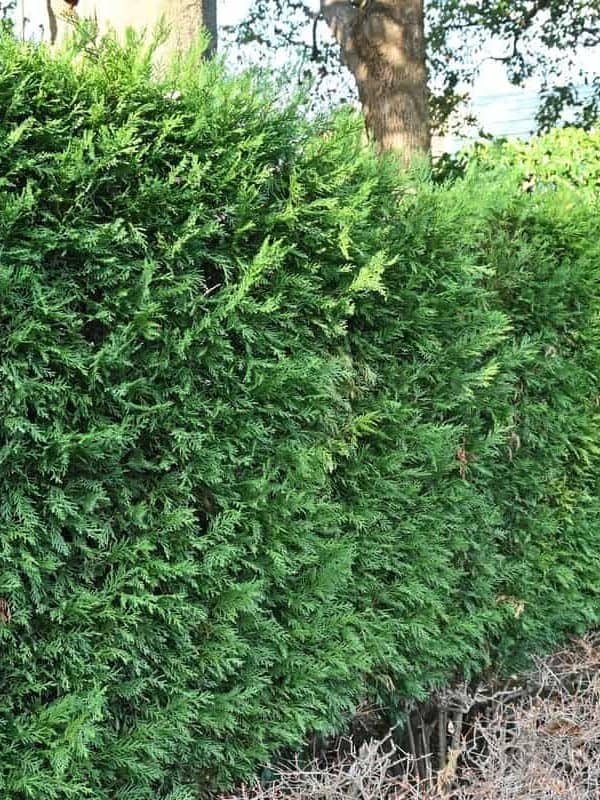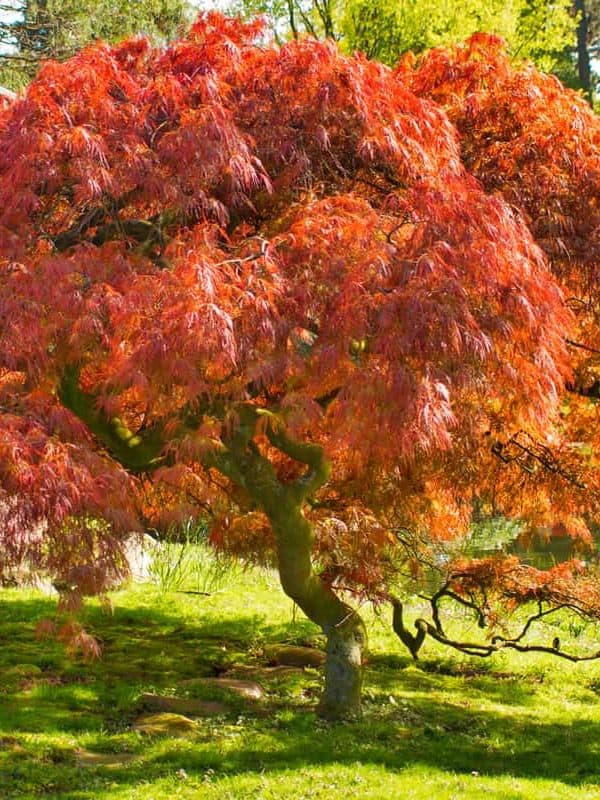Sometimes you have a hole in your garden, and you just want to be able to fill it with life and fill it quickly. Whether it's a large tree for a border along a road or between neighbors or low ground cover to fill in blank spots, one of these fast-growing plants should work for you. Check out these 22 fast-growing plants, with descriptions and care instructions, to see if any of them will coordinate nicely with your landscape.

22 Fast-Growing Plants For Your Garden
1. Creeping Jenny
![Garden large group of overhanging creeping jenny (Cerastium tomentosum). - Why Is My Creeping Jenny Dying [And What To Do About It]](https://gardentabs.com/wp-content/uploads/2024/03/Garden-large-group-of-overhanging-creeping-jenny-Cerastium-tomentosum.-edited.jpg)
Creeping Jenny (Lysimachia nummularia) is also known as moneywort. This low growing creeping ground cover is super for rock gardens, and anywhere you want low groundcover. It produces a mass of yellow blooms in June. This easy and fast-growing plant grows in USDA Zones 3-9, likes sun to partial shade, and medium-wet to wet ground. When planted in the shade, the foliage has a lime green color that's a real eye-catcher!
2. Clematis

Clematis (Clematis) is a deciduous perennial vine that is very long-lived. Plant it with its roots in the shade and let it spread onto a fence or trellis. It will bloom several times throughout the summer and comes in many different varieties and bloom colors. Clematis doesn't like to be moved after it's planted and potentially won't survive a transition. Clematis likes slightly acidic soil and regular amounts of moisture. It will grow in USDA Zones 4-9, depending upon the variety you choose for your garden.
3. Thuja "Green Giant"

Thuja or giant green (Arborvitae) is a fast-growing evergreen tree often used for shrubs and privacy borders. It's a large, vigorous, fast-growing evergreen—shooting up by as much as three feet per year until mature. Its natural pyramid form has dense, green foliage that darkens or bronzes slightly in the winter.
This is an exceptional landscape tree for use as a screen, hedge, or single specimen. It wind-resistant once established and can withstand heavy ice or snow, making it a good choice for a natural windbreak. Hardy from USDA Zones 5-7, giant green likes full sun or partial shade and well-drained soil.
4. Honeysuckle

Honeysuckle vine (Lonicera Japonica) is a heavenly smelling flowering vine. This beautiful plant will fill your garden with a sweet aroma while attracting bees, butterflies, and hummingbirds. If you need a flowering vine to cover a bit of wall or trellis, you might decide to give honeysuckle a try.
Honeysuckles are adaptable, enjoying many soil types and varying pH levels. The only thing it doesn't like is very wet, boggy soil. Honeysuckle thrives in full sun to partial shade, and hardiness varies depending on species.
5. Perennial Geranium

Perennial geraniums (Geranium) have long bloom seasons and a neat growth habit. The common name, cranesbill, comes from the shape of pointed, beak-like seedpods. These easy-care plants are best planted as a border, in containers, or as a spreading ground cover where their foliage and bright flowers can be admired. Geraniums like full to partial sun and fairly loamy soil. There are varieties for every region and zone.
6. Privet

Privet (Ligustrum) is a shrub used for borders and hedges. It's a fast-growing, deciduous (semi-evergreen in mild winter climates) shrub that grows 10' to 15’ tall and equally wide. It's been one of the most popular species of privet grown for hedging. It has flowers in June that give way to globe-shaped, glossy berries which ripen to black in fall and stay on through winter. These fruit clusters are the best ornamental feature of this plant.
Privet grows well in dry to medium moist soils and likes full sun to partial shade. It can be grown in USDA Zones 4-7.
7. Butterfly Bush

Butterfly bush (Buddleia davidii) is a gorgeous, fast-growing deciduous shrub that gets masses of long flowers on it that bloom throughout the summer. It's a real draw for butterflies, bees, and hummingbirds, and we recommend planting a few of these in your garden. They get quite tall, are hardy to USDA Zone 5, and are evergreen in Zones 8 and southward. These shrubs love full sunny spots and well-drained soil. There's also relatively deer-resistant.
8. Bamboo

Bamboo (Bambusoideae) is a fast-growing grass that is a common choice for a hedge or privacy screen. Varieties are available for USDA Zones 5 and warmer, but it is important to choose your area's correct species. Bamboo likes soil that is neutral to slightly acidic, and its rate of growth is directly affected by how well it likes the soil.
Each year, your bamboo will produce new plants, and those will grow taller than the parent plants. Each year's bamboo will achieve its full height of growth within 60-90 days. Give it plenty of water and allow it to dry out between waterings.
9. Hybrid Poplar

Hybrid poplar (Pacific albus) is a fast-growing tree similar to aspens. It's a farmed tree whose wood is used to manufacture pencils, palettes, and plywood. Though it's not super common as a residential tree, its beauty makes it a great candidate if you want an area of hardwood trees to grow quickly. This species is native to the Pacific Northwest.
10. Leyland Cypress

Leyland Cypress (Cupressus × leylandii) is a fast-growing evergreen tree with a pyramid or conical shape. Use it for hedges or privacy barriers at the edge of properties. Leyland cypress requires full sun to grow well, and when planted in the shade, rapidly thins out and sheds its lower branches.
This tree is ideal for USDA Zones 6-10. The tree grows three feet to four feet per year and reaches a height of about 60-feet to 70-feet and a spread of 15-feet to 25-feet. The Leyland is drought tolerant and hardy.
11. Japanese Maple Tree

Japanese maple (Acer Palmatum) is a gorgeous addition to any garden. There are a great number of varieties of these trees, so be sure to look for one like Osakazuki, which is fast-growing. This variety will grow to 18-feet in just 10-years, which is fast for a hardwood like a maple. These trees have gorgeous fall colors and are a perfect choice for a shady garden. These trees are hardy from USDA Zones 5-9 and prefer moist, slightly acidic soil.
12. Oleander

Oleander (Nerium oleander) is a small shrub from the dogbane family. It's sold and cultivated worldwide as an ornamental plant. This fast-growing evergreen plant produces masses of showy flowers in various colors from May through October. It's hardy in warmer USDA Zones 8-10 and grows from eight to ten-feet tall with an equal amount of spread. It likes full sun to part shade and medium moisture.
13. Marigold

Marigold (Tagetes) is a member of the sunflower family. This plant can be found in both annual and perennial varieties. They are easy-going and reliable and do well in a wide range of growing conditions. Once planted, marigolds grow rapidly. They thrive in full sun. Marigolds can also handle up to 20% shade if there is a bright sun for the rest of the day.
Marigolds can take poor to average soil without complaint as long as it's not soggy. In fact, marigolds bloom better and more often in poorer soil. Too rich of a diet stimulates lush foliage growth but lessens the number of blooms.
14. Petunias

Petunias (Petunia) are one of the most popular flowering annuals. These bedding plants sell at every big box store and even outside of your local grocery store when planting season comes around. They spread quickly and can fill an area of a flower bed quickly. They're also a very popular choice for hanging baskets.
The main thing petunias need is plenty of sunlight. They can deal with many soil types and will even be okay if they dry out a little bit.
15. Nasturtiums

Nasturtiums (Tropaeolum) are easy to grow flowers for your garden. Along with being beautiful, nasturtiums are edible. Use them as a colorful addition in salads or other dishes. With their pretty greenery and colorful flowers, nasturtiums are good for containers or as ground cover. They also have a pretty fragrance. Nasturtiums are perfect for growing in a summer garden because they grow so easily and rapidly.
Nasturtiums like full sun and regular watering, though they will do well in poor soil conditions. Some varieties will work in nearly every gardening zone.
16. Artemesia

Artemesia (Artemesia), also known as mugwort or wild tarragon, belongs to the daisy family. These easy-to-grow plants are great for sunny, dry areas. Because of their herbal nature, Artemesia has a slightly camphor-like odor, which is actually wonderful in the garden. Plant it with other herbs to fill out empty spots.
Artemesia attracts butterflies and is deer resistant. Many varieties have fragrant foliage as well as flowers that make good cut flowers. They are also drought tolerant.
17. Sweet Potato Vine

Sweet potato vine (Ipomoea batatas), an ornamental warm-season annual, is grown for its attractive leaves and vining habit. The foliage lends a tropical feel to the garden and comes in a range of colors and forms. These trailing vines work great as a summer ground cover.
They are perennials in USDA Zone 11, but anything higher they are planted past the last frost. They do best with up to six hours of sun per day but can tolerate some shade. Allow them to dry out between waterings but water them in times of drought.
18. Sedum

Sedum (Sedum), also known as stonecrop, is an easy to grow succulent that looks fantastic in a fall garden. There are creeping sedums and upright sedums for different characteristics in the garden. Sedums are great on hillsides and rock gardens and will grow quickly to fill in blank spots. Most sedums like full or part sun (five or more hours of direct sun per day) and generally prefer lean conditions, so go easy on the fertilizer.
19. Verbena

Verbena (Vervain) is a collection of gorgeous annual or perennial flowers known for their long bloom season and large blooms. They grow from a foot to a foot and a half tall and will spread between two to five feet wide.
Verbenas require a location that receives full sun throughout the day. They must have well-drained soil, and they will not tolerate overcrowding with poor air circulation, shade, or soil that stays overly moist. During their blooming period, give them a thorough watering once a week if they do not receive an inch of rain that week.
20. Daylilies

Daylilies (Hemerocallis) are not lilies, despite their name. These easy-to-care-for plants grow in clumps that grow larger from year to year. Each bloom lasts only a day (thus the name). They come in a variety of different colors. Plant them to cover a hillside or create a garden border. Daylilies establish quickly and overwinter without much issue.
They require at least six hours of sunlight per day. Daylilies don't like to compete with other shrubs and trees for nutrients, so it's best to give them their own zone in your landscape.
21. Hibiscus

Hibiscus (Hibiscus) is from the mallow family. Known for their bright, large, colorful blooms, these plants are known for both beauty in the garden and their uses for medicinal purposes in teas and supplements. Plant hibiscus in soil that is slightly acidic. It also needs moist soil to grow, but make sure it drains well.
22. Weigela

Weigela (Weigela) is a member of the honeysuckle family. This wild-looking shrub blooms profusely in the spring and will sometimes have a second bloom later in the summer. It's a friend to pollinators and has regular visitors in the form of bees, butterflies, and hummingbirds. The branches are somewhat arching, and the overall form of the shrub can be a bit messy, so it's not the best choice for a formal garden.
If you want an easy-to-care-for shrub that grows quickly and can fill in a hole in a border and provide you with gorgeous blooms, weigela might be for you. It likes partial shade, slightly acidic soil, and regular amounts of moisture.
Grow, grow, grow!
With this list of fast-growing plants, the perfect solution for your blank garden space is close at hand. We're happy you stopped by GardenTabs.com and hope you found the information you sought. For a few other great posts, please check out the suggestions below, and thanks for visiting!
19 Fast Growing Shrubs For Screening Purposes
11 Fast-Growing Evergreen Shrubs That Look Great All Year Long
